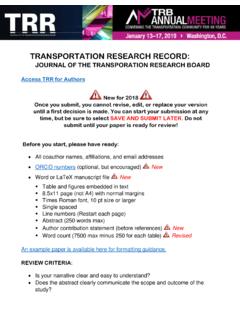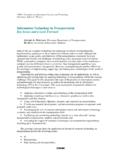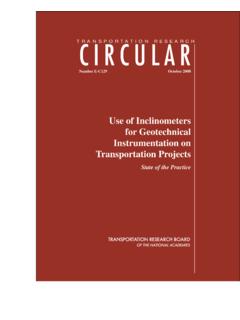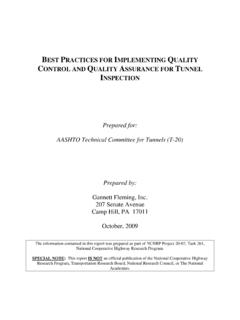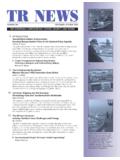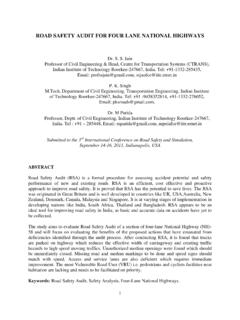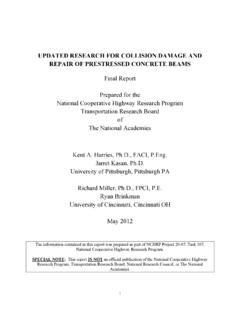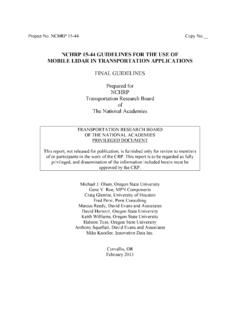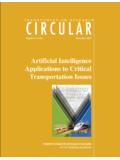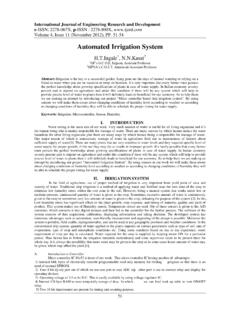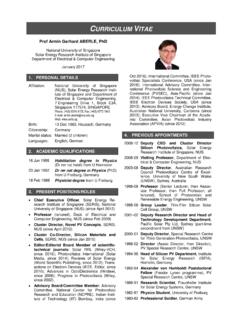Transcription of Airport Planning, Design, and Construction by Analyzing ...
1 A1J07: Committee on Aircraft/ Airport CompatibilityChairman: Michael T. McNerneyA Look into the Future of Airport planning , design , andConstruction by Analyzing current IssuesWILLIAM FIFE, Frederic R. Harris T. MCNERNEY, University of Texas at AustinAs we look toward a new millennium in air transportation, we must also look at the pastand the present. Future market forces that are impossible to predict will radically change thegrowth of the aviation industry, which is less than a century old. In order to analyze theaircraft of the future and the airports that will be compatible with these aircraft, one shouldlook also at what the industry sees as the emerging issues.
2 This paper provides a summaryoverview of the current issues that have been identified by the aviation community in theareas of Airport planning , design , and Construction . The process used to identify these majorissues was outlined and discussed during the proceedings of the American Society of CivilEngineers (ASCE) International Air Transportation Conference in Austin, Texas, in1998 (1).Discussions began at the ASCE International Air Transportation Conference inLouisville in June 1996, with a number of senior-level engineers, planners, and architectsconsidering the major issues they are and will be facing in the planning , design , andconstruction of domestic and international airports.
3 These discussions focused on the needto better identify these issues and engage in further dialogue regarding their implications forplanned and ongoing Airport development programs. Issues needed to be considered notonly from a planning perspective, but also from a design and Construction viewpoint. Issuesidentification began immediately after the June 1996 conference and has resulted in inputfrom more than 40 groups, including design and planning firms, architects, engineers,aircraft manufacturers, and Airport TRENDSTo put the emerging issues into proper context, many began their discussions with a reviewof the fundamental trends that are now being faced in the Airport and aviation key trends are outlined below: Changes in the airline industry, including route structures and airline hubbing.
4 Continuing growth in the airline passenger and air cargo markets; Government downsizing and increased focus on public-private partnerships; and Growth in the global economy and a changing worldwide political in the New Millennium2In considering these trends, it is clear that airports must be able to maintain a flexibleresponse to the dynamics of an industry in which rapidly changing technology and politicaland economic events often affect and reshape all aspects of Airport ISSUESThe issues outlined in this paper are only a brief summary of the whole array of issues facingairports.
5 Some of these areas of concern are continuing as well as emerging, but continuingin a new form (such as ticketless travel within the overall area of new technology).The process used to identify the specific issues outlined in the following discussioninvolved the development of a matrix that listed issues by source. Those issues thatappeared most frequently in each respondent s top 10 list became those that werehighlighted in this paper. As the survey results were tabulated over the past 3 years, itbecame clear that the four top issues were capacity and delay, new aircraft, environmentalconcerns, and four top issues are outlined along with some of the key subtopics or problemareas that were identified during the survey and DelayWith airports around the world experiencing higher and higher levels of delay, it was nosurprise that the issue of capacity and delay was at the top of almost every list.
6 With manyindustry analysts predicting a more than doubling of passenger traffic in the next 10 to 15years, the current delay problem will only worsen. To deal with these capacity and delayissues, additional public and private investment will be required. Among the concernsmentioned in this area are the will the transition to the future National Airspace System (NAS) be made andwho will be paying the bills? The 1926 Air Commerce Act directed the Secretary ofCommerce to develop lighted airways to let pilots see their route of flight at night.
7 Now wehave a nationwide system of airways using navigation aids nearly as obsolete. The new NASusing advanced technology is promised for the future, but how will it affect the airports andaircraft?What are the implications of flight delays at one Airport that affect airlines andpassengers nationwide? Denver International Airport is a great example of how building anew Airport to reduce delay in one city could result in reduced delays systemwide. As theNAS becomes still more complex, the interaction of delay and congestion at one Airport caninfluence the entire are serious concerns about Federal Aviation Administration (FAA) staffing andoutdated equipment.
8 The federal agency that regulates and controls aircraft movements andairport access has changed many times in the last 75 years. There have been discussions ofsignificant impending changes that will occur several times in the next century. How willthose changes affect the configuration and regulation of airports in the future?What are the implications of the changing fleet mix and new technology, such as theGlobal Positioning System (GPS)? What will the future aircraft fleet mix be at ourcommercial service airports?
9 Will super-jumbo aircraft be landing in large numbers? Will wehave growth in small aircraft made possible by advances in aircraft technology and large-scale production? Will a technology breakthrough eliminate the wake vortex problems thatAircraft/ Airport Compatibility3keep the spacing of landing and departing aircraft far apart? Advances in precision guided-instrument approaches are on the immediate horizon with differential GPS and precisionrunway monitoring (PRM). These new advances will provide near-term reductions in thedelay AircraftThe single most important issue concerning aircraft and Airport compatibility is concernabout the introduction of new super-jumbo aircraft.
10 The introduction of jet passengeraircraft into commercial service in 1958 created a critical need for longer runways atmajor airports. In 1970 the introduction of the wide-bodied Boeing 747 created theneed for another major revision to Airport infrastructure to accommodate aircraft thatcarried over 400 passengers and had a wing span of nearly 60 meters. However, lookinginto the crystal ball is difficult. Will the New Large Aircraft (NLA) proposed by Airbus andBoeing, which could have a wing span over 80 meters and carry over 600 passengers, reallybe built in large quantities?
